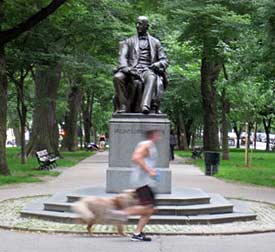

Photograph © James Sheldon
Boston’s nine-block long Commonwealth Avenue Mall links the Boston Common and Public Garden to the city’s great park system, The Emerald Necklace. Initially designed in 1856, with additional sections of the boulevard added over the following several decades, the mall is the central green axis of the Back Bay neighborhood. Its grace, scale, and definition of space make it one of the great physical features of Boston as well as one of world's finest examples of the tree-lined avenue. However, the cumulative effects of Dutch elm disease and deferred maintenance of its heavily-used turf now threaten the landscape.
History

(top) Courtesy Commonwealth Avenue Mall Committee;
(bottom) Courtesy The Cultural Landscape Foundation
Arthur Gilman designed the 32 acres of Commonwealth Avenue Mall in 1856 in the French boulevard style as part of his larger plan for Boston’s new Back Bay neighborhood. One of the early examples of urban planning, the design consisted of lawn panels, separated by a central pedestrian path; a cathedral-like canopy of double rows of trees; benches for leisurely conversations; and wrought iron fences at the entrance to each block. The initial nine-block portion of the mall was constructed between the late 1860s and 1881 and connected Back Bay Fens to the Public Garden and Boston Common.
In addition to American elms (Ulmus americana), sweetgum (Liquidambar styraciflua), green ash (Fraxinus pennsylvanica), maple (Acer rubrum), linden (Tilia Americana), zelkova (Zelkova serrata), and Japanese pagoda (Sophora japonica) trees were planted in organized rows to define the formal avenue. Nine monuments, starting with William Rimmer’s sculpture of Alexander Hamilton, also were installed along the expanding promenade. The City of Boston engaged Frederick Law Olmsted, Sr. to connect the mall to the Fens, the beginning of Boston’s famed Emerald Necklace of parks, which he had been commissioned to design. Additional sections of the boulevard were designed over the next several decades, however, the areas east of Charlesgate East are considered the historic core of this linear landscape.
By the 1960s, the allées had become the victim of both benign neglect and the highly destructive Dutch elm disease (DED). By the late 1960s, nearly half of the 600 elms on the mall were dead or dying. With little funding or attention, the mall fell into disrepair. The desperate state of the mall led to the development of the Commonwealth Avenue Mall Committee, an organization of neighborhood volunteers formed to partner with the city’s Parks Department to return the landscape to its original grandeur. The focus of the Committee was to be the trees of the mall: resulting DED immunization injections and pruning and fertilization programs have kept alive the last great urban stand of American elms in the region.
Portions of Commonwealth Avenue were listed on the National Register of Historic Places in 1990 and additional sections were added to the listing in 2003. Today, the mall remains an important element in the urban fabric and design of Boston. Its grace, scale, and definition of space make it one of the great physical features of Boston as well as one of world's finest examples of the tree-lined avenue.
Soil compaction from heavy use threatens the trees.
Courtesy Commonwealth Avenue Mall Committee
Threat
An early example of thoughtful urban planning, the mall is a beloved and heavily-used space. The success of the mall is also its greatest threat. The space was designed for the leisurely promenades of Victorian residents. Today, the park is traversed by commuting residents, customers of local businesses, and visiting tourists, and is used for organized events including the Boston Marathon, which draws hundreds of thousands of attendees to the city during a single weekend. Intense maintenance of the turf is necessary to protect the trees from compaction. Furthermore, the remaining historic elms continue to require monitoring in order to combat against Dutch elm disease.


